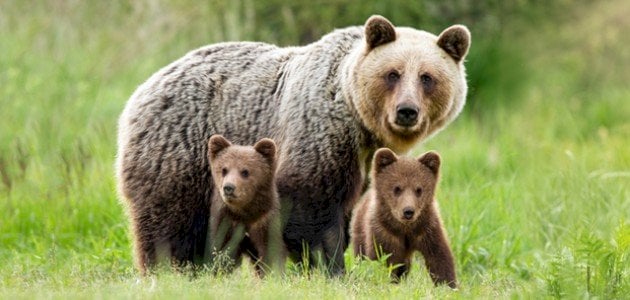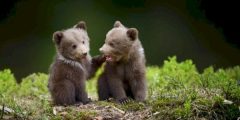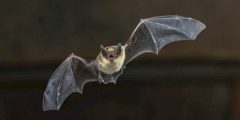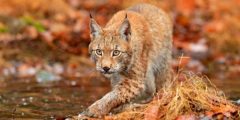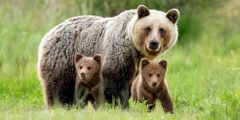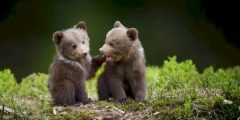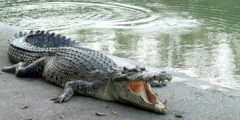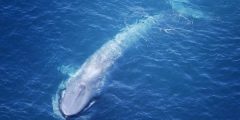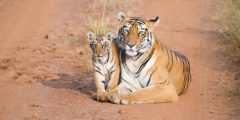The name of the bear's son
The son of a bear is called in the Arabic language: Al-Daisam.[XNUMX] (English: Cubs),[XNUMX] They are scientifically called (Ursidae).[XNUMX]
The birth of a bear son
The female bear gives birth in the month of January of the year with an average of 1-6 cubs at a time, and an average of 3 cubs in general, within a closed, warm, rocky environment. It is noteworthy that bears take the cavities of rocks or the cavities of trees as their dens.[XNUMX] The calf weight at birth is 0.682 - 0.907 kg.[XNUMX]
The mother provides care for her young for a period of up to a year and a half, after which the deer separates from the mother to search for its own area to live, and it is not far away, as it is within the area where it grew.[XNUMX]
Feeding the son of a bear
Cows feed mainly on mother's milk, which contains high levels of fat, reaching 20-25% of fat. When compared to human or cow's milk, we find that it is only 5-3%.[XNUMX]
It should be noted that the mother is able to produce milk and breastfeed the children during periods of lack of food and drink (hibernation). As it relies on its physical reserves to obtain energy, it often enters its core during the pregnancy period to hibernate and gives birth during this period.[XNUMX]
Read also:Information about the tigerThe cubs depend on the mother's milk for 2 years, but in the later stages the dependence on milk is less than in the first months after birth, as the cubs and the mother need external food sources to obtain energy in the next stage of hibernation.[XNUMX]
In the later stages, after weaning, the cubs become largely dependent on meat and some plants for their food, as they can feed on fish, insects, berries, nuts, and fruits.[XNUMX]
The formal characteristics of the son of a bear
The bear is generally characterized by its distinctive shape. The following are the most important physical and formal characteristics of the bear:[XNUMX]
- The desim is characterized by its very strong claws.
- Daisies are distinguished by their short tails.
- Polar vertebrates are distinguished by the color of their fur that is adapted to light, as it appears in yellow, grey, orange, and in some cases green. The reason for this is that the fur is transparent and hollow, and when light falls on it, some of it is absorbed and part of it is reflected, so these colors appear, and it often appears white because Reflects sunlight.[XNUMX]
- The wild bear is characterized by having multiple colors that are often dark, such as grey, brown, and black.[XNUMX]
- At the age of 5 months, cubs have teeth and fangs, the length of which reaches 1.5 cm. At the age of 5 months to 1 year, they lose the baby teeth, after which the permanent teeth and fangs begin to appear and develop until the age of 10 years.[XNUMX]
- Daisies and bears in general have membranes in their eyes that enable them to reflect light to improve vision, especially in the dark, which makes their eyes shine when light shines on them, as their eyes appear yellow-orange in the dark.[XNUMX]
Behavioral characteristics of the bear's son
Diasims have many behavioral characteristics that distinguish them from other animals, the most important of which are the following:[XNUMX]
Read also:Information about the female bear- The cubs are characterized by their social behavior when they are with the mother and other cubs, but they are solitary and anti-social when away from the family.
- Celestials make screams when they feel distress, and when feeding, they make purring sounds.
- Cockroaches follow the mother's sounds, grunts, and moans as a means of communicating and taking instructions.
- Bears and grizzlies use ground slaps and mouth air releases to communicate threat.
- Bears use their claws to leave marks on trees as a way to guide areas that contain food or not.
- Bulls and bears are generally found in areas with high levels of food sources, especially in areas containing oak and mulberry trees, and are able to exist in groups to maintain continuity and life.
- Bears, whether polar or wild, are found in personal areas called the home range, and therefore they do not show any defensive behavior to maintain large food areas, which makes them coexist with other animals from time to time.
- Bears, accompanied by cubs, expand their home range during periods of drought and lack of food and for the purpose of searching for food.
- Bears and grizzlies have high swimming abilities, which helps them to use some islands as living areas, especially during seasonal climate changes.
